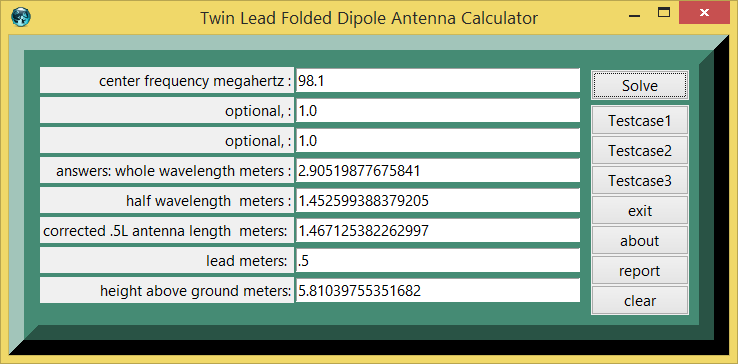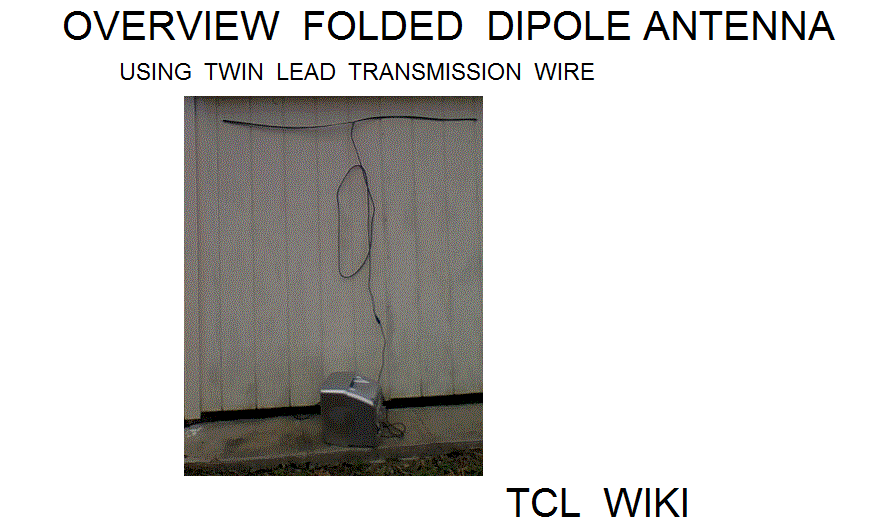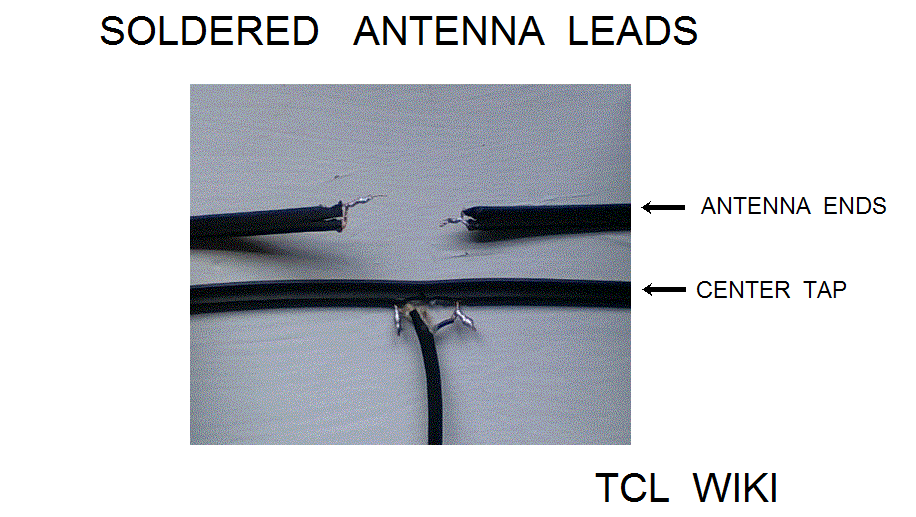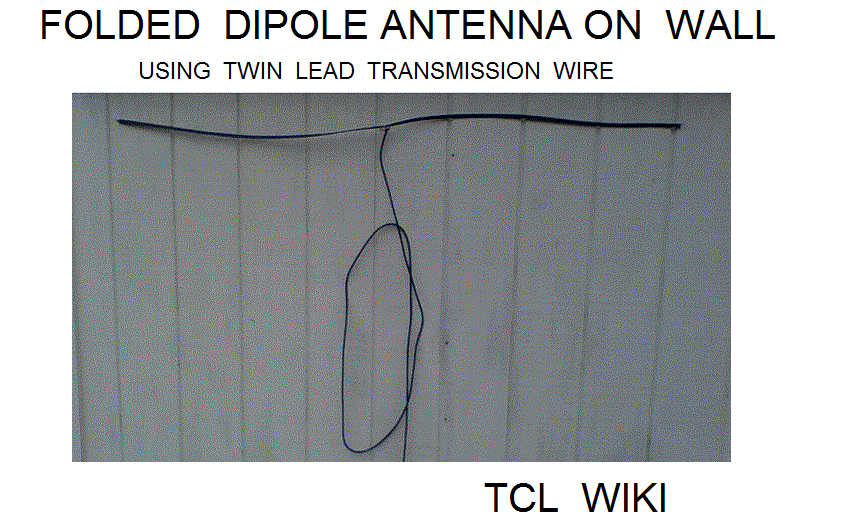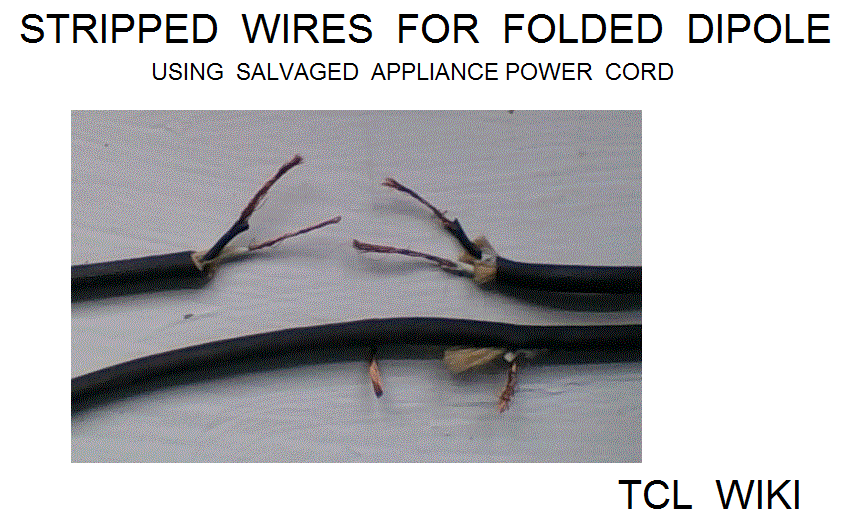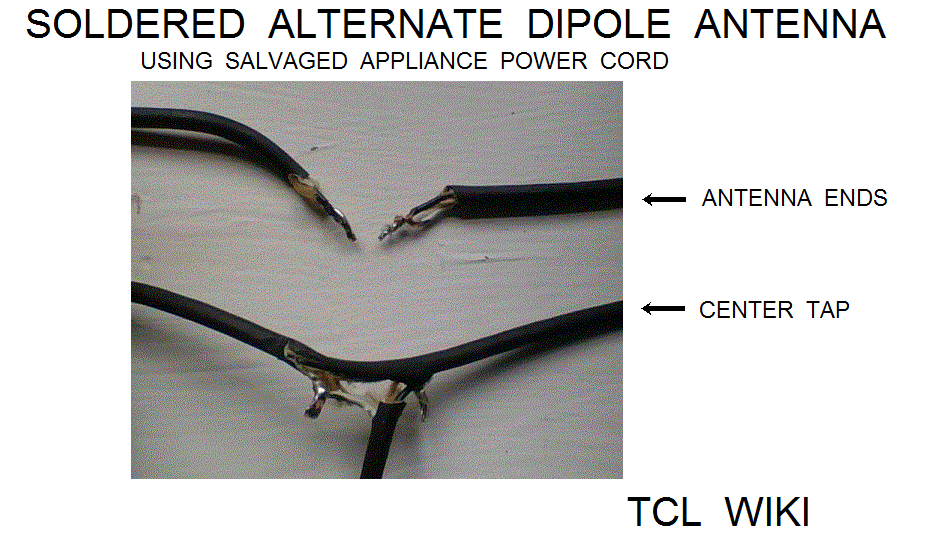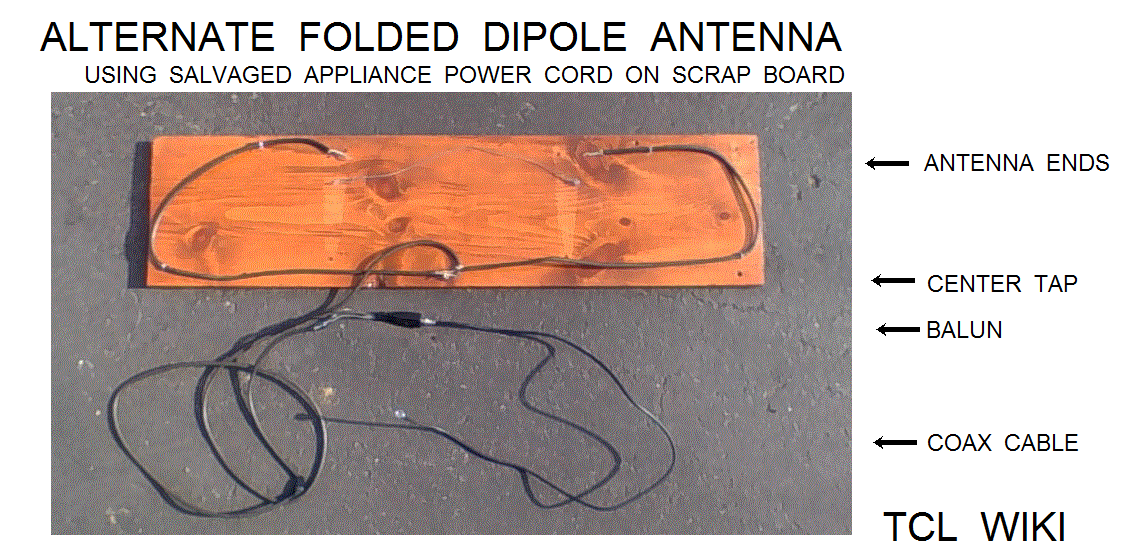Twin Lead Folded Dipole Antenna and example demo eTCL calculator
Twin Lead Folded Dipole Antenna and example demo eTCL calculator, numerical analysis
This page is under development. Comments are welcome, but please load any comments in the comments section at the bottom of the page. Please include your wiki MONIKER in your comment with the same courtesy that I will give you. Its very hard to reply intelligibly without some background of the correspondent. Thanks,gold
- Twin Lead Folded Dipole Antenna and example demo eTCL calculator, numerical analysis
- Introduction
- Alternate Text
- Appendix Code
- Comments Section
Introduction
gold Here is some eTCL starter code for a twin lead folded dipole antenna. The impetus for these calculations was checking calculations for a dipole antenna. Most of the testcases involve assumptions and rules of thumb.
The procedure starts with finding the radio wavelength in meters, wavelength = (velocity_factor*speed_of_light)/(megahertz* 1E6). The antenna length is set for half wavelength and is multipled by a correction factor for end distortion. The antenna height above ground is 2 wavelengths above ground.
# following statements can be pasted into eTCL console
set project 1.0 set wavelength [/ [* .95 300E6] [* 98.E6] ] # 2.908 meters set wavelength [/ [* .95 300E6] [* 57.E6] ] # 5.0 meters set wavelength [/ [* .95 300E6] [* 100.E6]] # 2.85 meters
Alternate Text
Gist. A computer program in Tool Control Language TCL was used to design a half wave dipole antenna for 100 Mhz on FM. The half wave dipole is excellent for classical music on city FM, but can be used (somewhat) for broadcast AM. Either twin lead or double appliance wire is used to increase effective conductor width or Antenna Bandwidth for FM reception. The wire antenna from scrap appliance cord is tacked to a varnished "pretty" wood board for cosmetics, if not in a college dorm or attic.
The antenna length is set for half wavelength and is multiplied by a correction factor for end distortion. The minimum antenna height above ground is 2 wavelengths above ground, but the used electrical cord can be tacked to roof rafters. The half wave dipole receives 100 MHZ FM with a gain of ~~2 dBi. Checking calculations for a folded dipole antenna, sometimes called a "T" antenna.
The procedure starts with finding the radio wavelength in meters, wavelength equals (velocity_factorspeed_of_light)/(megahertz 1E6). The antenna length is set for half wavelength and is multiplied by a correction factor for end distortion. The minimum antenna height above ground is 2 wavelengths above ground.
Crafting notes. The twin lead version of the "T" can be tacked at full length to a wall, ceiling, or attic rafter. In an alternate version, the halfwave antenna from surplus appliance cord antenna is tacked to a varnished "pretty" wood board for cosmetics, if not in a college dorm or attic. The surplus appliance cord on antenna was selected for economy, but the old fashioned wire was extra sturdy and easy to work with. In contrast to the appliance cord, the traditional twin lead wire was very difficult to stay put on the board. I am adding a generous fudge length of 2 inches to the initial wire cut for soldiering leads and tap placement. On the scrap boards of uncertain size, the antennas have end curls, and appear somewhat like the horn-shape of Texas long horn cattle. The smaller half wave dipole antennas receive 100 MHZ FM and (somewhat) Broadcast AM too, with an antenna gain of ~~2 dBi. Continuing as an experiment, the smaller half wave dipole antennas can be backed with a metal or foil sheet as reflector for higher antenna gain, ~~ 4 dBi . As a concept or thought experiment, it would seem possible that the constructed wire antenna could be tacked to a room corner or on a ceiling as a "V" antenna for higher antenna gain, ~~2X.
Testcases Section
In planning any software, it is advisable to gather a number of testcases to check the results of the program. The math for the testcases can be checked by pasting statements in the TCL console. Aside from the TCL calculator display, when one presses the report button on the calculator, one will have console show access to the capacity functions (subroutines).
Testcase 1
| table 1 | printed in | tcl wiki format |
|---|---|---|
| quantity | value | comment, if any |
| testcase number: | 1 | |
| 98.1 : | center frequency megahertz | |
| 1.0 : | optional | |
| 1.0 : | optional | |
| 2.90519877675841 : | wavelength meters | |
| 1.452599388379205 : | half wavelength meters | |
| 1.467125382262997 : | corrected .5L antenna length meters or 57.18895412844037 inches | |
| .5 : | antenna lead meters | |
| 5.81039755351682 : | height above ground meters |
Testcase 2
| testcase number: | 2 | |
| 100.1 : | center frequency megahertz | |
| 1.0 : | optional | |
| 1.0 : | optional | |
| 2.8471528471528473 : | wavelength meters | |
| 1.4235764235764237 : | half wavelength meters | |
| 1.437812187812188 : | corrected .5L antenna length meters or 56.046317682317685 inches | |
| .5 : | antenna lead meters | |
| 5.694305694305695 : | height above ground meters |
Testcase 3
| table 3 | printed in | tcl wiki format |
|---|---|---|
| quantity | value | comment, if any |
| testcase number: | 3 | |
| 57.1 : | center frequency megahertz | |
| 1.0 : | optional | |
| 1.0 : | optional | |
| 4.991243432574431 : | wavelength meters | |
| 2.4956217162872156 : | half wavelength meters | |
| 2.5205779334500877 : | corrected .5L antenna length meters or 98.25282661996499 inches | |
| .5 : | antenna lead meters | |
| 9.982486865148863 : | height above ground meters |
Screenshots Section
figure 1.
figure 2.
figure 3.
figure 4.
figure 5.
figure 6.
figure 7. Alternate Salvage Antenna stripped
figure 8. Alternate Salvage Antenna tinned
figure 9. Alternate Salvage Antenna Mounted on Scrap Board
References:
- goggle "twin lead dipole"
- Wikipedia on dipole
- Antennas, see snowflake antenna, tikalon blog,
- May 16, 2016, Dev Gualtieri, excellent article
Appendix Code
appendix TCL programs and scripts
# pretty print from autoindent and ased editor
# Twin Lead Dipole Antenna calculator
# written on Windows XP on eTCL
# working under TCL version 8.5.6 and eTCL 1.0.1
# gold on TCL WIKI, 15dec2016
package require Tk
namespace path {::tcl::mathop ::tcl::mathfunc}
frame .frame -relief flat -bg aquamarine4
pack .frame -side top -fill y -anchor center
set names {{} {center frequency megahertz :} }
lappend names {optional, :}
lappend names {optional, :}
lappend names {answers: whole wavelength meters :}
lappend names {half wavelength meters :}
lappend names {corrected .5L antenna length meters: }
lappend names {lead meters: }
lappend names {height above ground meters:}
foreach i {1 2 3 4 5 6 7 8} {
label .frame.label$i -text [lindex $names $i] -anchor e
entry .frame.entry$i -width 35 -textvariable side$i
grid .frame.label$i .frame.entry$i -sticky ew -pady 2 -padx 1 }
proc about {} {
set msg "Calculator for Twin Lead Folded Dipole Antenna
from TCL WIKI,
written on eTCL "
tk_messageBox -title "About" -message $msg }
proc pi {} {expr acos(-1)}
proc calculate { } {
global answer2
global side1 side2 side3 side4 side5
global side6 side7 side8
global testcase_number
incr testcase_number
set side1 [* $side1 1. ]
set side2 [* $side2 1. ]
set side3 [* $side3 1. ]
set side4 [* $side4 1. ]
set side5 [* $side5 1. ]
set side6 [* $side6 1. ]
set side7 [* $side7 1. ]
set side8 [* $side8 1. ]
set megahertz $side1
set conv_factor $side5
set speedoflight 300E6
#set velocityfactor .87 ; alternate velocity factor
set velocityfactor .95
set wavelength [/ [* $velocityfactor $speedoflight] [* $megahertz 1E6 ] ]
set halfwavelength [* $wavelength .5 ]
set antennacorrection [* $halfwavelength 1.01 ]
set antennalead .5
set heightaboveground [* 2. $wavelength ]
set side4 $wavelength
set side5 $halfwavelength
set side6 $antennacorrection
set side7 $antennalead
set side8 $heightaboveground
}
proc fillup {aa bb cc dd ee ff gg hh} {
.frame.entry1 insert 0 "$aa"
.frame.entry2 insert 0 "$bb"
.frame.entry3 insert 0 "$cc"
.frame.entry4 insert 0 "$dd"
.frame.entry5 insert 0 "$ee"
.frame.entry6 insert 0 "$ff"
.frame.entry7 insert 0 "$gg"
.frame.entry8 insert 0 "$hh"
}
proc clearx {} {
foreach i {1 2 3 4 5 6 7 8 } {
.frame.entry$i delete 0 end } }
proc reportx {} {
global side1 side2 side3 side4 side5
global side6 side7 side8
global testcase_number
console show;
puts "%|table $testcase_number|printed in| tcl wiki format|% "
puts "&| quantity| value| comment, if any|& "
puts "&| testcase number:|$testcase_number | |&"
puts "&| $side1 :|center frequency megahertz | |&"
puts "&| $side2 :|optional| |& "
puts "&| $side3 :|optional| |& "
puts "&| $side4 :|wavelength meters| |&"
puts "&| $side5 :|half wavelength meters | |&"
puts "&| $side6 :|corrected .5L antenna length meters or [expr $side5*39.37008] inches | |&"
puts "&| $side7 :|antenna lead meters | |&"
puts "&| $side8 :|height above ground meters| |&"
}
frame .buttons -bg aquamarine4
::ttk::button .calculator -text "Solve" -command { calculate }
::ttk::button .test2 -text "Testcase1" -command {clearx;fillup 98.1 1. 1.0 2.908 1.45 1.46 .5 5.8}
::ttk::button .test3 -text "Testcase2" -command {clearx;fillup 100.10 1. 1.0 2.85 1.425 1.439 0.5 5.7 }
::ttk::button .test4 -text "Testcase3" -command {clearx;fillup 57.10 1. 1.0 5.0 2.5 2.525 0.50 10.10 }
::ttk::button .clearallx -text clear -command {clearx }
::ttk::button .about -text about -command about
::ttk::button .cons -text report -command { reportx }
::ttk::button .exit -text exit -command {exit}
pack .calculator -in .buttons -side top -padx 10 -pady 5
pack .clearallx .cons .about .exit .test4 .test3 .test2 -side bottom -in .buttons
grid .frame .buttons -sticky ns -pady {0 10}
. configure -background aquamarine4 -highlightcolor brown -relief raised -border 30
wm title . "Twin Lead Folded Dipole Antenna Calculator" Pushbutton Operation
For the push buttons, the recommended procedure is push testcase and fill frame, change first three entries etc, push solve, and then push report. Report allows copy and paste from console.
For testcases in a computer session, the eTCL calculator increments a new testcase number internally, eg. TC(1), TC(2) , TC(3) , TC(N). The testcase number is internal to the calculator and will not be printed until the report button is pushed for the current result numbers. The current result numbers will be cleared on the next solve button. The command { calculate; reportx } or { calculate ; reportx; clearx } can be added or changed to report automatically. Another wrinkle would be to print out the current text, delimiters, and numbers in a TCL wiki style table as
puts " %| testcase $testcase_number | value| units |comment |%" puts " &| volume| $volume| cubic meters |based on length $side1 and width $side2 |&"
Comments Section
Please place any comments here, Thanks.
| Category Numerical Analysis | Category Toys | Category Calculator | Category Mathematics | Category Example | Toys and Games | Category Games | Category Application | Category GUI |
